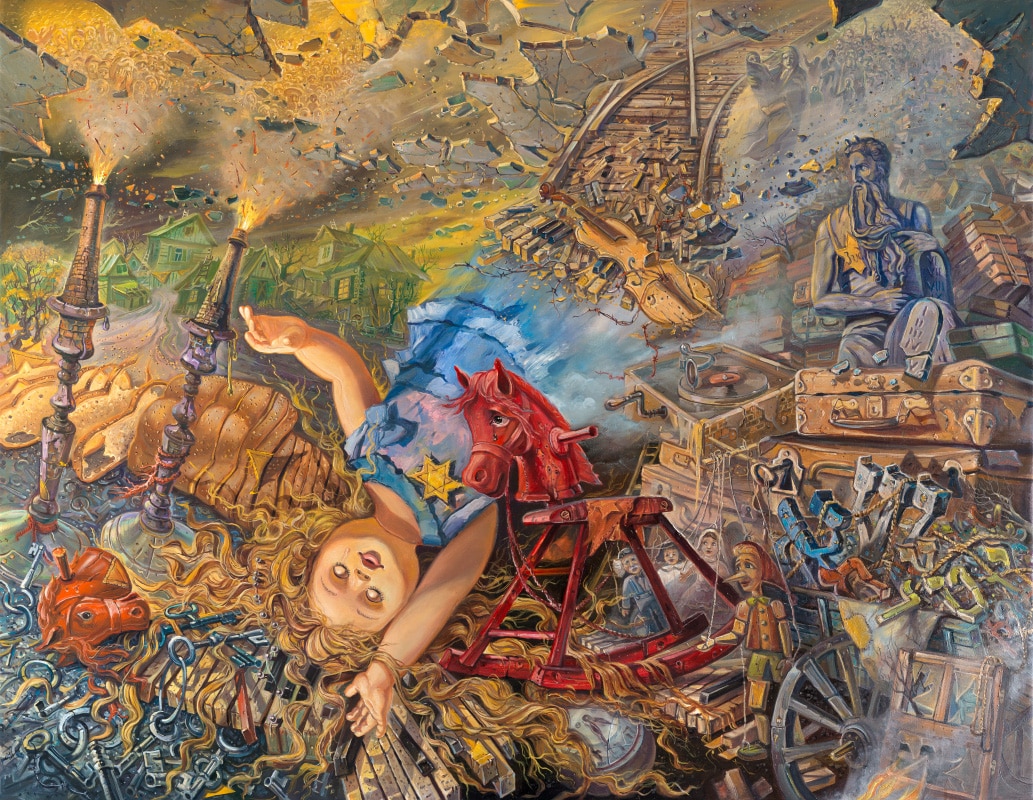
An Israeli artist Alex Levin, Jewish in spirit, has come a long way to the topic that many masters do not dare touch all their creative life.
And it can be understood.
It would seem that everything has already been said about it.
What can be more vivid than documents of that time: pictures of people behind barbed wire, heaps of women’s hair, rails leading to Auschwitz gates.
But Alex ventured.
A composition of this painting requires at least a minimum knowledge of Jewish history.
Nevertheless, even those who are not familiar with it at all will recognize the image of Moses, created by the great master of the Renaissance.
However, Alex depicted Moses with a yellow star of a ghetto prisoner.
Perhaps, it is a sentence to European civilization, with which many civilized Jews had been in love for several centuries in a row.
They had left ghettos for it, had left their people, and had used baptizing, like Heinrich Heine, in order to buy an “entrance ticket to European culture”.
But in the middle of the most civilized century this culture betrayed them, betrayed without protecting.
Still, why did not great Moses protect himself and his people, why did he allow them to drive himself and his brothers into ghettos and concentration camps?
Why was not there its own Moses of the XX century who would have led the Jews from European Egypt into the Promised land when the right time had come?
The cost of this double-edged failure, this double defeat was too high.
Who will bring back to Sabbath tables festive lamps that suddenly started to look like gas chamber pipes?
Who will bring back a musician to the violin, and a child to his lost doll with the Star of David?
Things outlived their owners.
It seems that the artist wants to turn back time, to destroy the rails leading into Auschwitz, which the Allies’s aviation spared for some reason.
And only the letters of the Jewish alphabet remain alive in this painting.
Toy letters that were presented to children who came to a heder.
They were smeared with honey to make studying the Torah look sweeter for kids.
These letters also passed into oblivion, but they returned later.
They returned into the books of Israeli pupils, they are shining by the entrance to Synagogues and in shop windows of fashionable stores, the words of Israeli anthem Hatikva (The Hope) are woven from them.
And they can still be used to put together the immortal words, repeated by the Jews all over the world, Shma Israel! (Hear, O Israel: the Lord our God, the Lord is one!)
And so it will be forever!
This painting is about faith and its limits.
About the fact that faith and prayer, traditions that the Jews had been following for dozens of centuries, did not save them in the years of the World fire.
A synagogue is collapsing; a Menorah is ripped out of the sanctuary with its roots again.
Buy looking at this painting, we understand how right is the comparison of a Menorah with a tree, the Tree of Life from the Garden of Eden, the Tree of the knowledge of Good and Evil, a family tree.
Great sages look helpless, their faces and the faces of their pupils, the faces of their wives and children are already dead.
It seemed to many people 70 years ago, that the Jewish people and its culture already did not exist and never would…
The gates of Hell open in the place, which should be the top of holiness in the Ark, where Torah scrolls are kept.
Moses tables a symbol of morals and world civilization are about to collapse, because all the bases of good and justice were disregarded. The Nazi are piercing the bodies of old men, women and children with daggers with swastika, which have the words “a God is with us!” inscribed in a Gothic script.
So where is God, what side is He on?
Such a complicated question, and maybe even unsolvable for someone, the artist sets before those who are looking at his picture.
Without providing a straight answer, Alex finds a place on his canvas for a small modern girl in a white and blue dress. Her dark curly hair cascade freely down her shoulders. She came from our present world where there is a state with the same-colored flag as this girl’s dress.
She is looking at people who died long ago, and we understand that this is a painting within a painting.
The presence of this child on the canvas testifies that our enemies will never be able to defeat our people.
They will not be able to do it, because not only we survived, but also we remember what happened and tell our children about it.
Even if it is hard for them to look at it.
However, they need to know about the Holocaust so that it will not happen again!
Alexander Riman
Researcher of the Jewish Heritage and Journalist, Israel

